-
 1518 Hits
1518 Hits
-
 80.49% Score
80.49% Score
-
 12 Votes
12 Votes
|
|
Article |
|---|
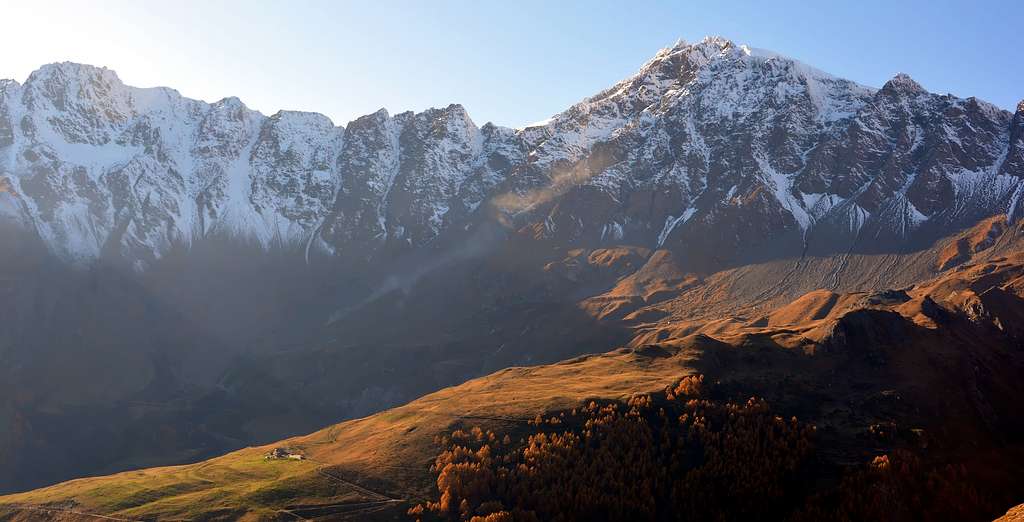
Premise for a very dangerous wall
B) - GREAT Combins / MOUNT VELAN - LEFT SIDE Second Part, but in a context that was precisely the entire sector of the Pennine Alps as to analyze all that was between the Col Ferret and Valpelline until the Dent d'Hérens and Les Grandes and Petites Murailles, as well as the internal areas to the Central Valley of Baltea. A very large area to visit and where the wall of Velan, as described in detail, was lost in the ocean of information. Here in this Route you want instead only focus on the same, especially with regard to its early history and returning, for those who want to know more, to complete the job, but that is beyond the target that you want to search here. So with regard to the ways more "modern", which opened after the descent via the same 1890 (Ellis Carr, William Martin Conway, F.M. Davies with Swiss Guides Ulrich Kaufmann and Joseph Marie Lochmatter) and the ascent of the Abbots Pantaléon Bovet and Marie Joseph Henry 1904, it is making a brief mention. The first in December of the same year created by the same itinerary, with Evanzio Blanc and Valerien Jaccod, the first ever winter to Velan starting from the Alps Champillon above Doues; to find another climbs you have to wait 1927/28, while the sector of Horns Velan had been visited by Antonio Frisoni, Cesare Negri, Luigi Vavassori and Carlo Viraudo end of June 1920, preceded in July 1916 by Mario and Nunzia Borelli on the Southeast Wall of Tête (Head) Ariondet (3485m). Beyond the wall slopes and are still climbing the Henry Guide Théodule Forclaz in September 1912 to "Southeast Couloir des Chamois" (3259m) towards the hill of the same name, always the same in October 1912, on the South-southeast Face of Mont Capucin (3395m), while the Wall South of Mont Cordine (3329m) is signed by Giovanni Soncelli and Paride Tagliabue in August 1939. But this part from Tête d'Ariondet towards the Valsorey Pass (3107m) comes from the speech of the "real" wall, here defined as the area between the Saddle of Faceballa (3280m) and Tête. Incidentally this is the sector that recorded the first explorations through Saddle Faceballa and the great couloir that descends immediately to the East of the same resulting in the moraine above the namesake alp (2385m).
Then we go back for a moment on these old-growth and glorious footsteps, marking a particularly historic Mont Velan.

Il Mont Velan o V'lan si trova nelle Alpi Pennine, subito a Sudovest del Gruppo dei Grands Combins e quindi posizionato sul confine tra Italia e Svizzera. Montagna alquanto complessa, é formata da cinque versanti dei quali due sono rivolti ad ognuna delle due nazioni. Ci interessa parlare di quello rivolto a Sud-sudest sopra la Conca di By ed i Comuni di Allein, Doues ed Ollomont. Due creste contengono quest'ampio settore: la Cresta Sud-sudovest che lascia scendere un frastagliato contrafforte raggiungente al suo termine il Mont Saron (2681 m) sopra Allein; il margine Settentrionale invece é delimitato dall' altrettanto lunga ed accidentata cresta di frontiera che arriva fino al Col di Valsorey (3107 m), sopra Ollomont e la superiore Conca di By. Ma é sicuramente il terzo comune, cioé Doues (1176 m) appena sopra ed ad Occidente del Comune di Valpelline nonché della sua omonima vallata, che s'identifica maggiormente con il Mont Velan ed il suo Versante Meridionale che eternamente lo sovrasta insino agli alti pascoli di Champillon. Avevamo già parlato della grande Parete Sud-sudest del Mont Velan (3734 m) in "My List" del 10 Maggio 2010 e più precisamente in: B)- GREAT COMBINS / MOUNT VELAN - LEFT SIDE Second Part, ma in un contesto trattante appunto l'intero settore delle Alpi Pennine tale da analizzarne tutto ciò che fosse compreso tra il Col Ferret e la Valpelline sino alla Dent d'Hérens e Les Grandes e Petites Murailles, nonché le zone più interne fino alla Valle Centrale della Dora Baltea. Un'area molto vasta da visitare e dove la parete del Velan, per quanto dettagliatamente descritta, si perdeva nell'oceano dell'informazioni. Qui in questa Route si vuole invece soltanto mettere a fuoco la medesima, soprattutto per quanto riguarda la sua storia iniziale e quindi vecchia rinviando, per chi ne voglia più sapere, a quel lavoro completo ma esulante dall'obiettivo qui cercato. Quindi per quanto concerne le vie più "moderne", ovvero aperte dopo la discesa tramite il medesimo del 1890 (Carr, Conway, Davies con le Guide Svizzere Ulrich Kaufmann e Joseph Marie Lochmatter) e la salita degli Abati Pantaléon Bovet e Joseph Marie Henry del 1904, si effettua un breve accenno. Il primo nel Dicembre dello stesso anno realizzò con lo stesso itinerario, insieme ad Evanzio Blanc e Valérien Jaccod, la prima invernale assoluta al Mont Velan partendo dall'Alpe Champillon sopra Doues. Per riscontrare ulteriori salite si dovrà attendere il 1927-28, mentre il settore dei Corni del Velan era stato visitato da Frisoni, Negri, Vavassori e Viraudo a fine Giugno 1920, preceduti nel Luglio 1916 da Mario e Nunzia Borelli sulla Parete Sudest della Testa d'Ariondet (3485 m). Oltre la stessa digrada e troviamo ancora le ascensioni dell'Henry con la Guida Théodule Forclaz a Settembre del 1912 al "Couloir Sudest des Chamois" (3259 m) verso l'omonimo colle, sempre gli stessi ad Ottobre 1912 sul Versante Sud-sudest del Mont Capucin (3395 m), mentre la Parete Sud del Mont Cordine (3329 m) porta la firma di Giovanni Soncelli e Paride Tagliabue nell'Agosto 1939. Ma questo tratto dalla Testa d'Ariondet al Col de Valsorey (3107 m) fuoriesce dal discorso della "vera" parete, intesa come settore compreso tra la Sella (3280 m) ed appunto la Tête. Daltronde é quello che ha registrato le prime esplorazioni tramite la Sella ed il canalone discendente subito ad Est sfociando nella morena sopra all'omonima alpe (2385 m). Torniamo quindi per un momento sopra queste vetuste nonché gloriose orme, che segnano un momento particolarmente storico del Mont Velan.
S-SE Couloir from Faceballa Saddle (3280 metres about) and exit out on Ice Cap (3734m),
by "Faustin" Savoye
Relative Routes
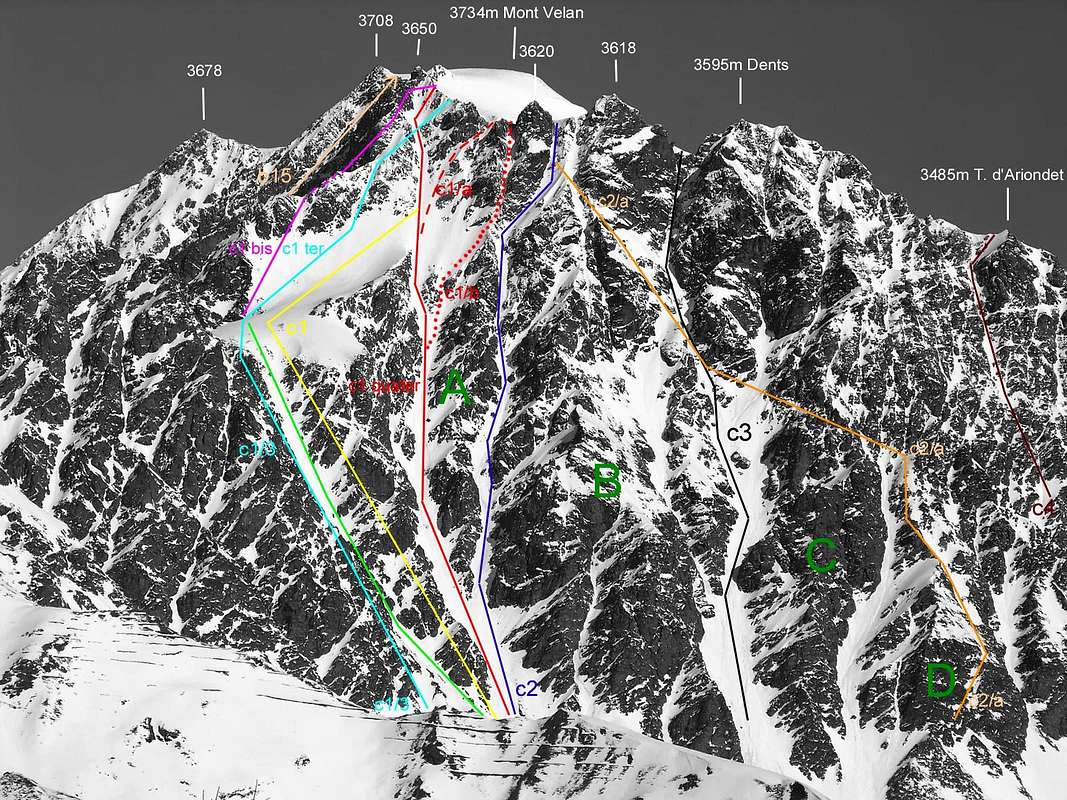
Picture by Antonio, traced by Osw
MONT VELAN (3734 m) S-SE FACE from right or East by halfcircular ascent progressively to the left or West: Starting, along the route from Valsorey 's Pass (Normal Via; 3107m), from Testa d'Ariondet also Tête de Riondet (Ariondet Head) (3485m), Ariondet 's "Carving" (3480 metres about), Velan's Little Tooth (about 3530/35 meters), Velan's five Dents ( or Jags; the major or highest and more Western 3595 metres), Jags's Saddle (3557 metres about), Velan's three Horns with the (Eastern 3618 metres about, Mini Central 3615 around and barely noticeable, Western 3620m ), Horns Eastern Brèche (3610/12 metres about), Horns Western Triple Brèches (3605 metres about, 3608 metres about, 3628/30 metres about), Quota 3650 metres, Quota 3672 metres, Quota 3708 metres (towards Molline/Menouve Vallons) to the rounded Ice Cup or true Mont Velan or Mont V'lan Summit (Ice Cup; 3734m). To the left or Northwest: Quota 3678 metres (towards Molline/Menouve Vallons) with the West Crest descending above the Hannibal's Pass (2992m), just at the end of the same valley and between the Italian/Swiss border. VELAN South PILLARS or Southern rocky RIBS, with the relative COULOIRS and GULLIES:
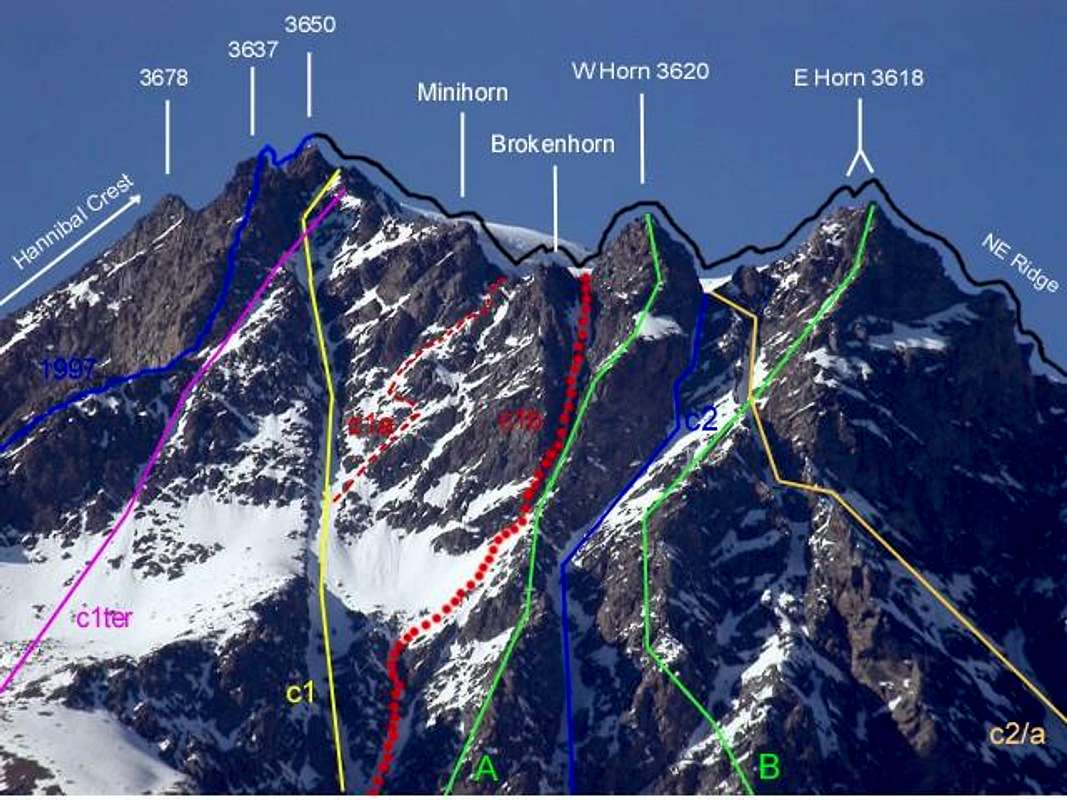
Picture by Antonio, traced by Osw
AOSTA VALLEY in SUMMITS MOUNT VELAN EKITS OUT to HORNS Mont Velan's HORNS EXITS OUT toward the HORNS ROUTES about 850/900 metres high From left (West): *Just starting from the Hannibal 's Western Crest of the Quota 3678 meters: towards the Ice Cup Mount Velan also the true Top; on August 31th, 1779 (first absolute ascent); Summer 1826 (entirely in descent, after the third ascent absolute). S-SW Ridge July 27th, 1997, in descent from Quota 3650 meters. C1ter Diagonal Route to West Triple Brèche July 15th, 1976, in ascent (3628/30m~). (lemon yellow color) Western Great CouloirC1)- August 16th, 1890, in descent; June 14th, 1904 in ascent (partially), from Faceballa Saddle. December 28th, 1904 (idem in First winter absolute of mountain and integral in descent). ** Routes from (in descent) also towards the (in ascent) Quota 3650 meters; even from or to West Triple Brèche (3628/30m~). Minihorn Central Triple Brèche (3608m~): c1a)-, with the second part of descent through the Southern Great Couloir C1, July 18th, 1997, in descent from East Triple Brèche (3605m~) between Minihorn and Brokenhorn (with bifid top) into the Great Couloir or C1quater Via; c1b)- July 18th, 1997, in ascent and in day towards the rocky carving between the doubelr and smaller Brokenhorn and Western Horn, after the first part through the Southern Great Couloir C1. West Horn 3620 metres; A)- July 25th, 1997, in ascent by "Hourglass Pillar" always in day. West Horn Western Brèche (3610/2m~); c2)- July 25th, 1997, in descent by "Narrow Gully/Couloir". Eastern Horn (3618 meters~); B)- September 27th, 1998, in ascent by Southern Pillar with integral descent in day by (lemon yellow color) C1 into the great Southern Couloir, as from the route of August 16th, 1890 by Ellis Carr, William Martin Conway, F.M. Davies with the swiss guides Ulrich Kaufmann and Joseph Marie Lochmatter. West Horn Western Brèche (3610/2m~) from base with progressive traverse to the left or West on Central Pillar, Central great Couloir and, (ocher yellow color), c2/a)- June 28th, 1920. Climb combined with the following crossing always to the left or West briefly with traverse, before in almost horizontal route and after in diagonal to the Northwest, on South Pillar of more East Horn and below the next smaller Central Horn reaching a carving just under and in right (East) of the most Western Horn. IMPORTANT NOTE: Complicated and complex way, also rather dangerous because it is very exposed to falling stones, that in practice begins at the base of (see photo above) D = Velan 's Jags towards the VI ° Tooth or more Eastern Pillar also "Angular Broken Double Southern Pillar", as soon as previous the wide East-southeast face of sixth Dent or Little Jag (just detached East-southeast; about 3530/35 meters). Therefore there are no other routes on the rocky Teeth between the great double gully of c3; also the new route into the snowy and icy couloir towards the Teeht 's "Carving" or Jags's Saddle (3557 metres about). Ascent by Osvaldo Cardellina, on August 27th, 1995, lone, in day and through descent along the Southern Great Couloir, route of August 1890 and labelled with (lemon yellow color) C1) and the "Halved Couloir", just preceding the traversal route c2a of June 1920. Even the large sector of the gully between c3 (of C = Southern Central Pillar towards the V ° Tooth; always see the picture above) ) and c2a is quite dangerous due to the identical reasons and there is no type of ascension below the five plus one teeth. Farther East, under the Testa d'Ariondet with c4 route; there is the via of 25 July 1916 of Mario and Nunzia Borelli. It is also known of an attempt (by a climber engaged on the difficult, wide and triangular wall of the Testa d'Ariondet) in the first decade of the 2000 with a mountaineer recovered however by helicopter. *** East-northeast Ridge from Valsorey Pass (3107m): Monks of Gr. St. Bernard D'Allèves and Marquis on Summer 1826 (in occasion of third absolute of mountain ascent) with route in the highest final part. East-northeast Ridge or Standard Via with variant integral from and towards the Valsorey Pass (3107m): August 17th, 1975, Osvaldo Cardellina, Marco Cossard, Camillo Roberto Ferronato, Giuseppe Lamazzi and Roberto Meneghini in ascent and in descent (with during the descent by Osvaldo Cardellina, lone, the second absolute ascent of Doigt du Velan (Velan 's Finger); 3314m) and in day from the Pastures of By 's Conca; first entire and integral. Repeated by Osvaldo Cardellina, "Gigi" Gadin and Faustin Savoye, July 15th, 1976 second complete and integral, in descent, after the "Diagonal Gully" in ascent.

Picture by Antonio, traced by Osw
MONT VELAN (3734m) S-SE and E-SE FACES of ALL SUMMITS ON the ROCKS * From left (West) ALL Rocky ROUTES: * 1799, Aug. 31th: Westerner Ridge or Hannibal's Crest: Abbot Gr. St. Bernard and Naturalist Laurent-Joseph Murith and the Hunter Genoud in superior third of crest (in left by B14)- ), after initial ascent on W-NW Slope of crest in FIRST ABSOLUTE ASCENT of MONT VELAN. 1826, on Summer; Abbots D'Allèves and Marquis in descent integral to Hannibal Pass. 1997 Routes: , Jul. 27th, 1997 Souhwestern Ridge (amongst 1872/b15)- and of 1973/c1bis)- routes; Osvaldo Cardellina, lone, in descent and in day from Mont Velan 's Quota 3650 metres to Faceballa Pass. 1997, July 25th: South-southeastern Face, by Western Horn South Pillar also "Hourglass Pillar"; Osvaldo Cardellina, lone and descent in day with integral, by Western "Narrow Couloir" (c2)- ). 1998 Routes: Sep. 27th, 1998: S-SE Face, by Eastern Horn 's Southern Pillar; Osvaldo Cardellina, lone and descent integral in day, by Western Great Couloir (c1quater)- ). (lemon yellow color) 1920 Route: Jun. 28th, 1920: S-SE Wall, by Velan's Jags or Teet South Central Pillar c2/a; partial in inferior part, crossing to the left or West towards Central Great Couloir (c3)- and Eastern Horn South Pillar) to more Eastern Horns Brèche; Antonio Frisoni, Cesare Negri, Luigi Vavassori and Carlo Virando. 1916 Route: Jul. 25th, 1916: of Ariondet Head , by c4 via and traverse to Ariondet "Carving" on E-NE Great Crest or c5)- that is Italian Normal Route; Mario Borelli and Nunzia Borelli. 1912 Route: Oct. 17th, 1912: Mont Capucin Southeast Face, between c5)- , c6)- routes (dated but not marked in pictures); Abbot Joseph Maria Henry and Mountain Guide Théodhule Forclaz. 1939 Route: Aug. 17th, 1939: Mount Cordine SE Face, between c6)- , c6bis)- routes (dated but not labelled in pictures); Giovanni Soncelli and Paride Tagliabue. ** In high against the sky and on Italian/Swiss border, in year 1826, on Summer: East-northeast Crest lomg ascent by the two Abbots of the Great Saint Bernard Pass D'Allèves and Marquis, in superior part from the more Western Velan's Horns (3620m) towards the Ice Cup Summit. 1976, Jul. 15th: East-northeast Ridge Osvaldo Cardellina, Luigi Gadin and Faustin Savoye, in day and in integral descent from Ice Cup Summit to Valsorey Pass and, in the same day, Velan's Finger or Jag second absolute ascent, by Osvaldo Cardellina, lone, after the first by the Abbot Joseph Maria Henry in August 11th, 1922. *** In purple color, the various Cols or Passes, Saddles, Brèches and snowy "Carvings" or rock "Notches": 1)- Faceballa Pass (3239m); 2)- Faceballa Saddle (3280m); 3)- Quota 3650 meters; 4)- Western Triple Brèche (3628/30, 3608, 3605 metres about); 5)- Eastern Brèche (3610/2 metres about); 6)- Jags's Notch (3557 metres about); 7)- Ariondet "Carving" (3480 metres about); 8)- Capucin Pass (3376m); 9)- Southwestern Chamois Pass (3259m); 10)- Southeastern Chamois Pass (3420 metres about) and just before the "Plateau de Cordine" (about 3221 meters), preceding the Col de Valsorey (3107m).
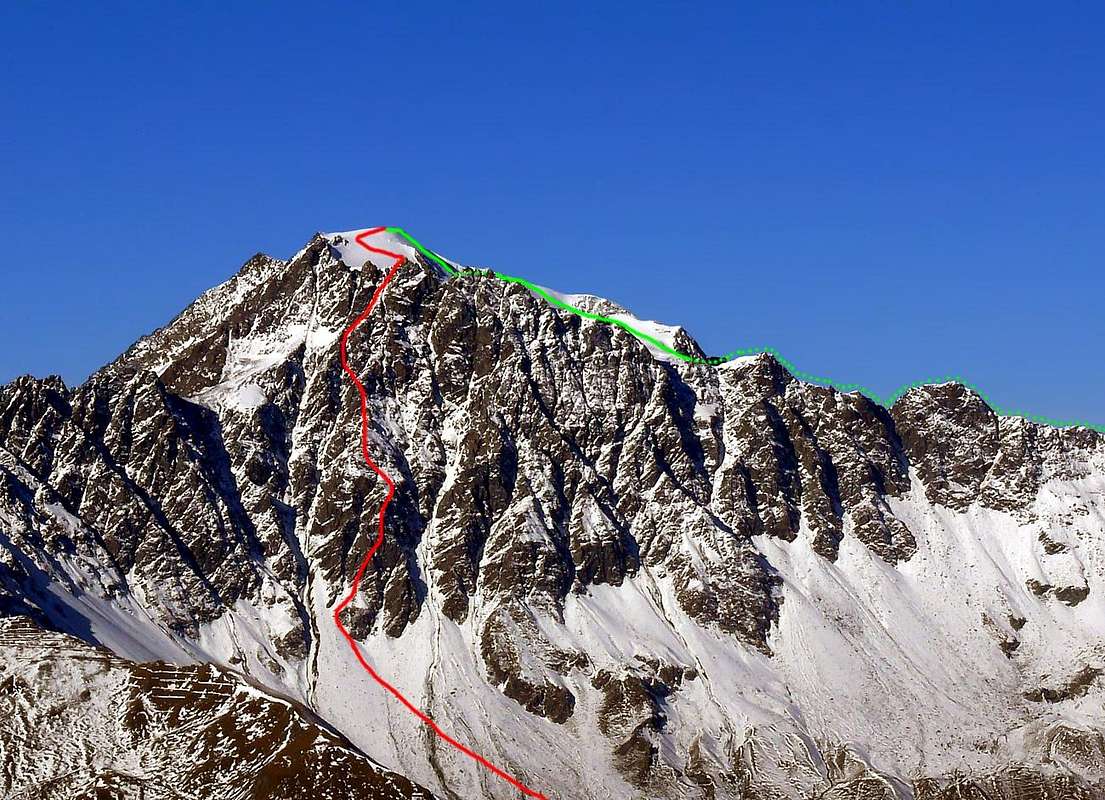
Picture & traced by Antonio
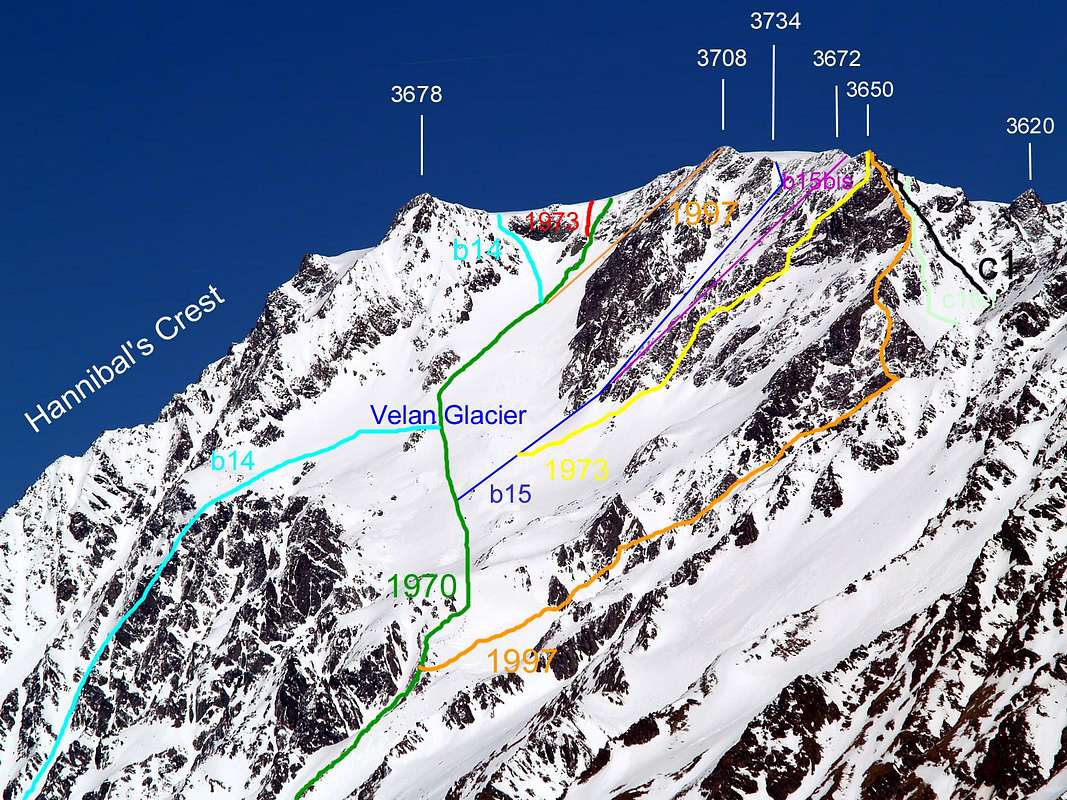
Picture by Antonio, traced by Osw
* The other and opposite to the West face of MONT VELAN or V'LAN (3734m) S-SW FACE (Molline/Menouve) Frontally from left: Western Crest or Hannibal's Ridge at the end of double and deep Menouve/Molline Valley and from the homonym Pass Aug. 31th, 1779, ( Laurent-Joseph Murith and Génoud), in ascent, by West Slope and in superior part from Quota 3400 metres around; in descent and in integral 1826 (the two abbots of the Gran San Bernardo Col scilicet the swiss D'Allèves and Marquis). ** S-SW SLOPE (Menouve and the superior Molline Vallons): starting from low or from the current Molline's Bivouac (2415m; since 2005) into the superior Molline Vallon, towards the Saddle about 3640 meters, in ascent b14)- . Sep. 04th, 1901, (Guido Cibrario, Franco Viale and swiss Mountain Guides Daniel Balley and Omer Balley); Southwest Face "Superdirect route" in ascent and crossing of all summit small dômes (3678, 3670, 3734, 3708, 3672 metres), in day from Prailles small Hamlet (1500 metres about). Sep. 06th, 1973, (Osvaldo Cardellina and Renzo Botti); SW Face "Direct Route", in descent. Oct. 31th, 1970 (Gino Buscaini and Silvia Metzeltin Buscaini); NW Wall of Quota 3708 meters, in ascent and in day from Quaye Alp (1600 metres about). Jul. 27th, 1997 and in day (Osvaldo Cardellina, lone); Western Wall of Quota 3708 meters, variant on a small pillar of the more Western Face of Quota 3708 meters with ascent in day from Quaye Alp (1600m~). Always by initial approach with the same routes of ITALIAN SKI-MOUNTAINEERING ROUTE. Aug 31th, 1999 and in day (Osvaldo Cardellina, solo) W-SW "Inclined Couloir" of the Quota 3708 meters, at the Double Northern Saddle 3650 meters about , in descent b15)- . Sep. 03th, 1872 (H.J. Leaf, Walter Leaf ) with swiss Mountain Guide Hans Baumann and Valtournanche Mountain Guide Daniele Bich; West Face of Quota 3672 metres towards the Double South Saddle 3647/50 metres around, in ascent b15bis)- . Jul. 15th, 1902 (Agostino Ferrari, Edoardo Garrone with Valtournanche Mountain Guide Cesare Meynet); SW Wall of Quota 3650 meters, in descent. Sep. 06th, 1973 and in day, (Osvaldo Cardellina and Renzo Botti); S-SW Ridge of Quota 3650 metres to the Faceballa Saddle 3280 metres, in descent. Jul. 27th, 1997, in day (Osvaldo Cardellina, lone). *** S-SE FACE (Comba Berruard/By Basin): side on right (East): from Faceballa Saddle 3280 metres towards the S-SE WALL, above Berruard Comba/By Conca or Basin, in right (East): Little Saddle 3450 metres about, S-SW Ridge and S-SE Wall, in ascent (c1bis)- , unmarked and no traced in photo). Oct. 31th, 1970 (Gino Buscaini and Silvia Metzeltin Buscaini); S-SE diagonal Gully and S-SE Great Couloir, in ascent c1ter)- . Jul. 15th, 1976, in day (Osvaldo Cardellina, "Gigi" Gadin and Faustin Savoye) S-SE Face, Western Great Couloir, in descent c1)- . Aug. 16th, 1890 (Ellis Carr, William Martin Conway, F.M. Devies) with swiss Mountain Guides Hulrich Kaufmann and Joseph Marie Lochmatter. In ascent, by Faceballa Saddle with C1, Jun. 14th, 1904 (Abbots Pantaléon Bovet and Maria Joseph Henry ). In winter and in ascent with C1quater (see above the first photo) and in day from Champillon Alp! (2050m), by Faceballa Saddle, Dec. 28th, 1904 (Abbot Pantaléon Bovet, Evanzio Blanc and Maria Joseph Henry and Jaccod).In descent, by integral S-SE Western Great icy Channel (C1) towards Doues (1251 m).
Actually 2019










